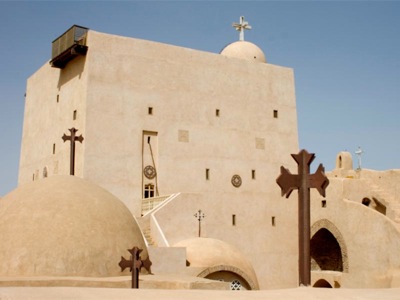THE COPTIC MONASTERIES TODAY
The monastery is a school for spirituality. Many people visit the monastery to receive the blessings by attaining the liturgy in the monastery, or to visit the holy place and enjoy peace. Others stay for a few days in the guest house in the monastery, especially the youth who stay at the youth retreat house and receive some counseling and participate in some activities in the monastery and may even visit the library to read or copy some of the manuscripts.Each ancient monastery includes a main church and many chapels, a refectory, a flour mill, a water well, a garden, a keep, a cemetery, some cells and the walls. There are also farms, different workshops and many other facilities. Today we have more than thirty active monasteries in Egypt and abroad, we also have many nunneries.

The keep, Al-Sorian, Wadi el-Natrun
THE COPTIC MONK TODAY
The first steps:
Any person who aspires to live as a monk frequently visits the monastery to know more about this life. After a certain period, the monastery may accept this person to become a monk after fulfilling all the criteria needed to be admitted into the monastery. He then stays for around three years as a novice before becoming a monk after a special ceremony in which he considers himself to be dead from the world and born in what we consider as the angelical life.
Everyday life of a monk:
Our main duties are permanent prayers and growing spiritually. Every morning we meet inside the church at four o’clock, we pray the midnight prayers followed by singing and praying the psalms and hymns in the Coptic language from the book we call the psalmodia. After we finish, at around six o’clock, some of us attain the liturgy (which depends on the time of the Coptic calendar) or we may go back to our cells to do some activities before we start our work at seven o’clock. At one in the afternoon we meet in the refectory to eat a communal meal. Afterwards, we go back to work until we meet again to pray the communal prayers. After this prayer each one of us is free to manage his life according to the monastic rules.
The monk’s activities:
Each monk contributes to the community, we have different duties to fulfill and we try to be a self-sufficient community. Each monk performs one of the duties in the monastery. In addition to the normal duties, some of the monks have additional activities such as writing books, painting icons or creating some hand activities. When need be, some of the monks travel to serve the Coptic communities outside the monastery.
The care for the monk:
The spiritual father, who is usually the abbot, cares about the needs of each monk individually. Although we have rules we also have personal differences. The abbot understands those differences and sets the rules accordingly to help each one of us to grow spiritually.
The types of monastic life:
In one monastery we have three different types of monastic orders. Some monks prefer to live as anchorites in the desert, others live as anchorites inside the monastery within its
walls, and the main group of monks live a communal life. The abbot helps the monk take his decision of choice by giving him the best possibility.
Father Cedrack
Amba Bishoy
St. Bishoy Monastery
Wadi el-Natrun, Egypt